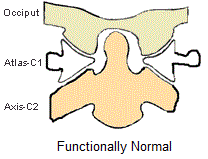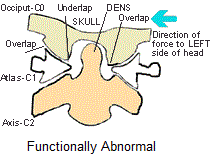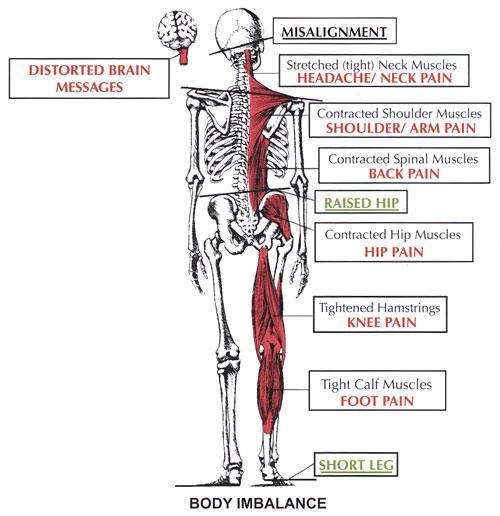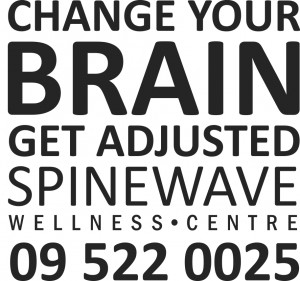 The term “subluxation” means “minor misalignment”, however the affects on the human body as a result of a subluxation of either the first or second cervical vertebra (atlas or axis) with respect to the skull can be far from “minor”.
The term “subluxation” means “minor misalignment”, however the affects on the human body as a result of a subluxation of either the first or second cervical vertebra (atlas or axis) with respect to the skull can be far from “minor”.
Upper cervical specific is becoming more widely searched for and recognised as a safe and effective technique for correcting upper neck subluxations.
Practicing upper cervical specific has given me the privilege of looking after many who fly into Auckland for care. Some of the stories are unbelievable.
Last month I worked with a couple who flew up from Christchurch to stay for a week. 8 years ago the husband was hit on the back of a head by a crate at work. X rays were “normal”. MRI was “normal”. Function was not normal. The impact a subluxation has on the human experience is most apparent in these cases when symptoms, over time, become extreme.
Minor atlas/axis misalignment alters the nervous system in the following ways:
- Reduced frequency of nerve firing to the brain
- Reduced oxygenated blood flow to the brain
- Decreased/increased muscle activity on one side of the body
 Over an 8 year period the husband lost his ability to work. He started getting chronic daily headaches. He became so light sensitive he had to wear sunglasses all the time, even indoors. He became chronically fatigued and lost all strength in his dominant hand. His concentration dropped through the floor and mental processes slowed. Ultimately, after seeing 25 medical practitioners, he was diagnosed with the problem being “all in his head”. Not one considered the spine.
Over an 8 year period the husband lost his ability to work. He started getting chronic daily headaches. He became so light sensitive he had to wear sunglasses all the time, even indoors. He became chronically fatigued and lost all strength in his dominant hand. His concentration dropped through the floor and mental processes slowed. Ultimately, after seeing 25 medical practitioners, he was diagnosed with the problem being “all in his head”. Not one considered the spine.
A fit, active, middle-aged man losing his life before his eyes with ACC, doctors and a psychologist telling him he’s, quote, making it up, unquote.
We worked together for 2 hours a day. By the end of the week, he had a headache-free day for the first time; he could momentarily take his glasses off indoors; and he gave me the biggest bear-grip handshake with his dominant hand. We were all moved to tears.
Chronic fatigue is often misdiagnosed and rarely is attention paid to the spine and brain. Altered nervous system integrity will create fatigue. This is due to changes in the brain’s fuel efficiency, the body’s oxygenation, and overall muscle tone.

Other factors can contribute to chronic fatigue: diet, gut, stress, viral, past trauma, smoking, weight, breathing etc. However all roads lead to brain. Problems are proportional to the amount of pressure placed on the nervous system. This will be reflected in posture as the body’s mechanical levers start to fail. Subluxations will be reinforced, and the cycle of negative feedback into the brain will continue, leading to more fatigue and decreased adaptability.
I began my Spinewave healing journey with my daughter Camille early October 2012. I’ve been unable to work for the last 6 years due to chronic fatigue and other health issues. It was late November 2006 when I slipped and fell down the wooden stairs in my house by the back door. In the fall several areas of my spine caught the hard edges of the wooden steps. I landed head first onto the tile floor hitting the right side of my head very hard. I was rushed to Auckland Hospital by ambulance and after a cursory examination by medical staff only the mid-part of my spine was X rayed.
After several hours in ED I was sent home and advised to have a few days off work. In the following weeks the only apparent residual effect was my very tender tail bone. Two months later I began to experience the beginnings of fatigue in the early afternoons. At the time I put this down to stress, not for one moment linking it to the fall. Over the next 3 to 4 months my energy levels continued to plummet and I began to have difficulty concentrating on tasks that required focused mental attention. By mid-2007 I was unable to continue working as a psychotherapist and had to make the very difficult decision to close my practice.
Over the next few years my overall health continued to decline. Although I suspected that my health problems were triggered by injuries sustained in the fall I had no evidence to confirm this. My chronic fatigue symptoms became so incapacitating that a “good day” was having a window of one hour of adequate energy in the middle of the day to do basic house-hold tasks. I found normal activities such as going to the supermarket incredibly stressful because of relentless brain fog that caused mental confusion and memory lapses. Conversations with friends and family did not flow as easily as before because I struggled to find the words to express my thoughts and feelings… sadly many connections simply faded away.
It’s difficult to convey the despair and deep anxiety I felt as my previously full life contracted into something very small and limited. The loss of health, career and social life was a devastating blow, and yet gave me a deep insight into the reality of what so many others with chronic ill health have to live with.
I tried many different kinds of healing modalities including acupuncture, osteopathy, homoeopathy, herbal medicine, supplements, cranial sacral therapy, and others I’ve long since forgotten. I found I became stressed and overwhelmed easily as my nervous system became reactive. My immune system and digestive system were both greatly weakened. Through the winters I’d be sick much of the time with a cold or flu inevitably ending up with bronchitis. I also had recurring pain in my right ear with tinnitus as well as on-going problems with my teeth. Since the accident I’ve had 5 root canals and 3 extractions. Prior to this my teeth were in very good condition. Yet despite all these health challenges, medical lab tests kept coming back as normal – apart from slightly elevated cholesterol.
As I was struggling to manage on my own, my eldest son suggested moving to Melbourne to live with him and his wife. However, it was difficult adjusting to life in a new country as I’d under-estimated the impact of my health challenges. After a year of further declining health; worsening brain fog, very high blood pressure, increasing lack of physical mobility and flexibility, I decided to return home to Auckland.
A week before I was due to fly back my neck suddenly became excruciatingly painful. At worst I could hardly hold my head up. It was very scary. I booked a session with a local chiropractor who was in walking distance and subsequent X rays revealed that my upper neck was badly twisted. As soon as I saw the X ray of my neck I knew, without a doubt, this was caused by the fall down the stairs. That night a Google search led me to the Spinewave website in Auckland. When I read these words on the website… when there is pressure on the brain stem the lights of the nervous system will begin to go out… I cried with relief. These words so accurately described what I was feeling in my body – the lights going out one by one. I felt a surge of hope after many long difficult years, and now I knew why I had to get back to Auckland, fast!
I’ve experienced a remarkable improvement in my health since beginning treatment at Spinewave with Dr Neil Bossenger. My energy levels have greatly increased to where I’m now able to take my dog for a brisk half hour walk each day. When I first returned to NZ I struggled to walk to the letterbox. My brain fog symptoms have cleared considerably: my memory has greatly improved together with general cognitive functioning. In short, I can think better and communicate with others more easily and naturally. I’ve also noticed significant improvements with my vision and hearing, as well as muscular flexibility. I feel I’m well on the way to making a full recovery this year after only five months of treatment. My quality of life is better in every way.
Thank you Neil for your high quality professional care. Thank you Pip for your warm welcome each visit. I’ve shared my story to encourage others who have suffered a blow to the head, even if the injury seems to be minor, to seek help from an upper cervical chiropractor as soon as possible!
Karen Lupe 2013
© Dr Neil Bossenger 2013

